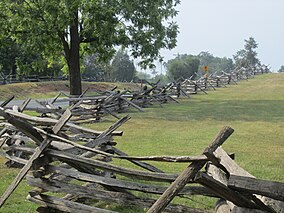This article includes a list of general references, but it lacks sufficient corresponding inline citations. (August 2024) |
| Manassas National Battlefield Park | |
|---|---|
 Period fence at Manassas Battlefield | |
| Location | Prince William County, Virginia, U.S. |
| Nearest city | Gainesville, Virginia. U.S. |
| Coordinates | 38°48′46″N 77°31′18″W / 38.81278°N 77.52167°W |
| Area | 5,073 acres (20.53 km2)[1] |
| Established | November 14, 1936[2] |
| Visitors | 715,622 (in 2005) |
| Governing body | National Park Service |
| Website | Manassas National Battlefield Park |
Manassas National Battlefield Park | |
| NRHP reference No. | 66000039[3] |
| Added to NRHP | October 15, 1966 |
Manassas National Battlefield Park is a unit of the National Park Service located in Prince William County, Virginia, north of Manassas that preserves the site of two major American Civil War battles: the First Battle of Bull Run, also called the Battle of First Manassas, and the Second Battle of Bull Run or Battle of Second Manassas. It was also where Confederate General Thomas J. Jackson acquired his nickname "Stonewall". The park was established in 1936 and listed on the National Register of Historic Places on October 15, 1966.
More than 700,000 people visit the battlefield each year. The Henry Hill Visitor Center, on Sudley Road by the south entrance to the park, offers exhibits and interpretation regarding the First Battle of Bull Run, including Civil War-era uniforms, weapons, field gear and an electronic battle map. The center offers the orientation film Manassas: End of Innocence, as well as a bookstore.
A recent find in 2014 unearthed bone fragments that led to the discovery of the skeletal remains of two Union soldiers in what is now thought to be a Surgeon's Pit. The remains were found among the bones of several other limbs in the pit. Carbon dating shows that the pair died during the Battle of Second Manassas, also known as Second Bull Run, in August 1862. The remains were moved on Tuesday, June 19, 2018, and transferred from the National Park Service to the US Army who will be burying them in Arlington National Cemetery.
- ^ "Listing of acreage – December 31, 2020" (XLSX). Land Resource Division, National Park Service. Retrieved 2021-08-15. (National Park Service Acreage Reports)
- ^ "Park Anniversaries". Retrieved 13 August 2021.
- ^ "National Register Information System". National Register of Historic Places. National Park Service. March 13, 2009.

